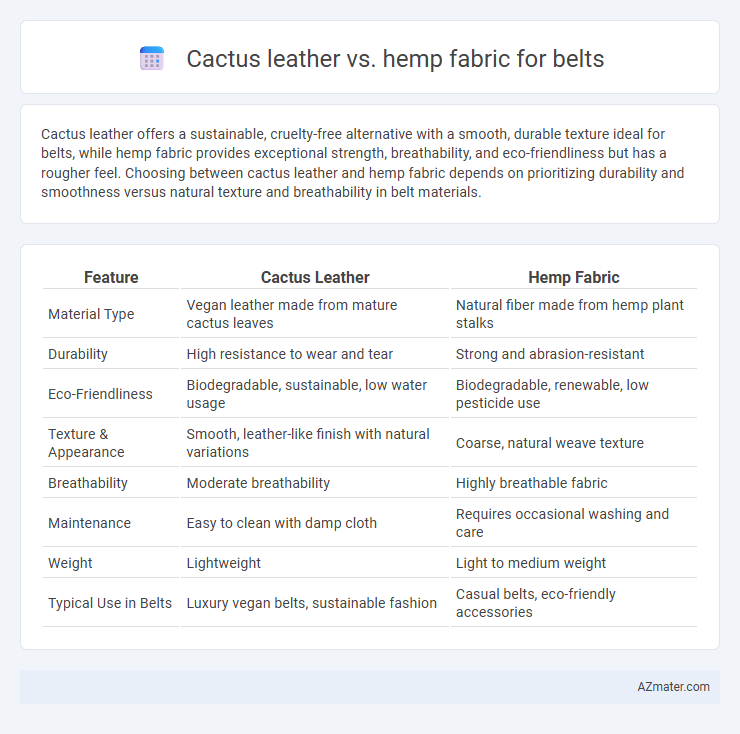Cactus leather offers a sustainable, cruelty-free alternative with a smooth, durable texture ideal for belts, while hemp fabric provides exceptional strength, breathability, and eco-friendliness but has a rougher feel. Choosing between cactus leather and hemp fabric depends on prioritizing durability and smoothness versus natural texture and breathability in belt materials.
Table of Comparison
| Feature | Cactus Leather | Hemp Fabric |
|---|---|---|
| Material Type | Vegan leather made from mature cactus leaves | Natural fiber made from hemp plant stalks |
| Durability | High resistance to wear and tear | Strong and abrasion-resistant |
| Eco-Friendliness | Biodegradable, sustainable, low water usage | Biodegradable, renewable, low pesticide use |
| Texture & Appearance | Smooth, leather-like finish with natural variations | Coarse, natural weave texture |
| Breathability | Moderate breathability | Highly breathable fabric |
| Maintenance | Easy to clean with damp cloth | Requires occasional washing and care |
| Weight | Lightweight | Light to medium weight |
| Typical Use in Belts | Luxury vegan belts, sustainable fashion | Casual belts, eco-friendly accessories |
Introduction to Sustainable Belt Materials
Cactus leather and hemp fabric represent innovative, eco-friendly materials for sustainable belt production, significantly reducing reliance on animal hides and synthetic fibers. Cactus leather is crafted from mature cactus leaves, offering durability, water resistance, and biodegradability, while hemp fabric is derived from fast-growing hemp plants known for their strength, breathability, and minimal environmental impact. Both materials contribute to lowering carbon footprints and promoting ethical fashion by utilizing renewable resources and reducing waste in the accessory industry.
What is Cactus Leather?
Cactus leather is an innovative sustainable material made from the mature leaves of the nopal cactus, processed into a durable, vegan alternative to traditional leather. It offers a biodegradable and cruelty-free option with natural UV resistance and water repellency, making it ideal for eco-conscious belt production. Hemp fabric, while also sustainable and strong, differs by being a plant-based textile derived from hemp fibers rather than a leather substitute.
Overview of Hemp Fabric
Hemp fabric, derived from the fibers of the Cannabis sativa plant, is renowned for its durability, breathability, and eco-friendly cultivation process requiring minimal water and pesticides. Compared to cactus leather, hemp fabric offers a natural, biodegradable alternative with excellent moisture-wicking properties and resistance to UV light and stretching. Its strong, lightweight composition makes hemp fabric a sustainable and versatile choice for belts, appealing to environmentally conscious consumers seeking renewable materials.
Environmental Impact: Cactus Leather vs Hemp
Cactus leather, derived from the Opuntia cactus, offers a sustainable alternative with low water usage and biodegradable properties, reducing environmental strain compared to traditional leather. Hemp fabric cultivation requires minimal pesticides and grows quickly, enhancing soil health and carbon sequestration while demanding less water than cotton. Both materials drastically lower environmental impact compared to conventional leather, with cactus leather excelling in water conservation and hemp fabric offering superior regenerative agricultural benefits.
Durability and Longevity Comparison
Cactus leather offers exceptional durability, featuring resistance to wear and tear similar to traditional leather, making it ideal for long-lasting belt use. Hemp fabric is known for its high tensile strength and excellent abrasion resistance, contributing to strong, durable belts that improve with age. While cactus leather provides a smooth, resilient surface, hemp fabric offers breathability and flexibility, both materials ensuring belts maintain structural integrity over extended periods.
Comfort and Wearability
Cactus leather offers a soft, flexible texture that molds comfortably to the wrist, providing exceptional breathability and a lightweight feel ideal for long-term wear. Hemp fabric belts combine durability with natural moisture-wicking properties, ensuring comfort in various climates while maintaining resistance to stretching and wear. Both materials promote eco-friendly fashion, but cactus leather delivers a more luxurious softness, whereas hemp fabric excels in rugged durability and breathability.
Style and Aesthetic Differences
Cactus leather offers a sleek, smooth surface with a rich, natural grain that mimics traditional animal leather, lending belts a luxurious and sophisticated appearance. Hemp fabric displays a coarse, textured weave that provides a rustic, earthy aesthetic, appealing to those seeking a more casual or bohemian style. The choice between cactus leather and hemp fabric belts ultimately reflects a preference for either polished elegance or eco-friendly, rugged charm.
Cost and Market Availability
Cactus leather generally costs more than hemp fabric due to its sustainable production process and growing demand in the vegan fashion market. Hemp fabric remains more affordable and widely available, benefiting from established agricultural supply chains and higher production volumes. Market availability for cactus leather is expanding but still limited compared to the readily accessible and bulk-produced hemp fabric used in belt manufacturing.
Maintenance and Care Requirements
Cactus leather requires minimal maintenance, needing only occasional cleaning with a damp cloth and conditioning with natural oils to prevent drying and cracking, making it highly durable for belts. Hemp fabric belts demand more frequent washing and gentle care due to their natural fiber composition, which can weaken if exposed to harsh chemicals or excessive moisture. Both materials benefit from air drying and avoiding prolonged sun exposure to maintain their appearance and longevity.
Which is Better for Eco-Friendly Belts?
Cactus leather offers a sustainable alternative to animal leather, made from the fast-growing nopal cactus that requires minimal water and no pesticides, making it highly eco-friendly. Hemp fabric, renowned for its durability and low environmental footprint, requires less water and grows rapidly without harmful chemicals, making it another excellent choice for eco-friendly belts. Both materials reduce reliance on traditional leather, but cactus leather's biodegradable properties and lower processing impact often make it the better option for truly sustainable belt production.

Infographic: Cactus leather vs Hemp fabric for Belt
 azmater.com
azmater.com